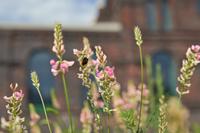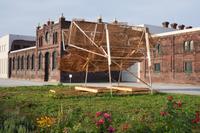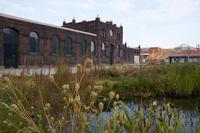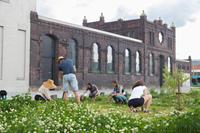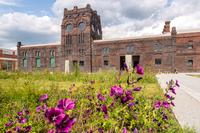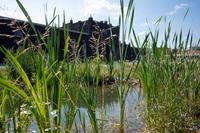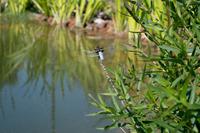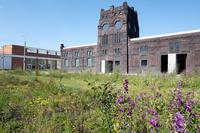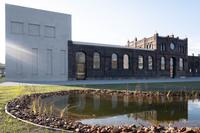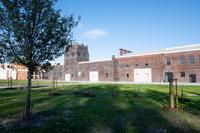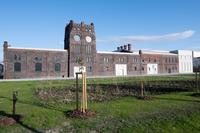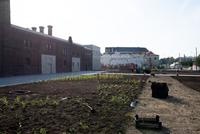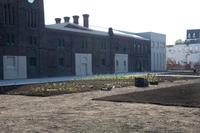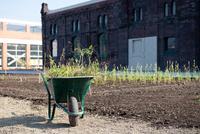garden of the present
We are preparing an updated version of the site. Thank you for your understanding.
Besides its exhibitions and other various programmes and activities, PLATO is also interested in what is happening behind the building’s brick walls. To spread knowledge and offer rest and consolation, PLATO has created a 7,600m2 public garden dedicated to people, insects, invertebrates and vertebrates, animals – whether terrestrial, aquatic and amphibian – and also of course plants and fungi. We have named it Garden of Presence.
The garden has been created according to permaculture principles that include the good use of different types of energy such as solar, water, wind, and others to be found in the location. The garden is being developed slowly over time, something that is necessary in order to establish a sustainable ecosystem. Constant change makes the garden resilient. The garden offers space to numerous organisms that create many beneficial connections among them, thus strengthening its immunity and increasing its ability to adapt to climate change.
Some plant species, planted as seeds, will wait for their moment and, as conditions change, gradually become a part of the meadow. The soil here was damaged by the industrial history of the city and so a task of the garden – among other things – is to regenerate it. The garden provides a place for vegetation to grow but also for manmade elements, created by artists, to make the stay in the garden more pleasant for everyone.
We dream of an open community garden in the city centre.
- Označení galerieOznačení
galerieLoukaLoukaLoukaMobiliářTrvalkové
záhonyKvětinové záhonyJeštěrkovištěMokřadKvětinové
záhonyJedlý lesLouka
rumištního typuBiotopPolodivočinaZeleninové
záhonyPobytový
trávníkKompostJedlý lesPLATO↓
Vstup do budovyVstup do budovy
↑Kavárnagalerijní prostor
Klíčová dírka
Ⅰ Shade, meadow, pasture and the scent of roses and lavender
˘ˇ˘ ˘ˇ˘ ˘ˇ˘ ˘ˇ˘ ˘ˇ˘ ˘ˇ˘ ˘ˇ˘ ˘ˇ˘ ˘ˇ˘ˇ˘ˇ˘ˇ˘ˇ˘ˇ˘ ˇ˘ˇ˘ˇ˘ˇ˘ˇ˘ˇ˘ˇ ˘ˇ˘ˇ˘ˇ˘ˇ˘ˇ˘ˇ˘ ˇ˘ˇ˘ˇ˘ˇ˘ˇ˘ˇ˘ˇ - Označení galerieOznačení
galerieLoukaLoukaLoukaMobiliářTrvalkové
záhonyKvětinové záhonyJeštěrkovištěMokřadKvětinové
záhonyJedlý lesLouka
rumištního typuBiotopPolodivočinaZeleninové
záhonyPobytový
trávníkKompostJedlý lesPLATO↓
Vstup do budovyVstup do budovy
↑Kavárnagalerijní prostor
Klíčová dírka
Currently, this part of the garden – which also includes a grass area – is mainly a flower meadow that attracts honeybees and provides food for insects and delights for human senses. In the meadow – which we started by planting seeds – you will find wild perennials such as daisy, ragged-robin, meadow crane’s bill, bird’s foot trefoil, vetch and others, as well as medicinal herbs suitable for drier environments. Both meadows are re-cultivation sites, meaning plants should improve the damaged soil.
Other beds of perennial plants include angelica, artichoke, garlic, crownvetch, stachys, daylily, oregano, estragon, fennel, bugloss and viper’s-bugloss, hedge mustard, field scabious, white horehound, clover, sweet clover, comfrey, valerian, horseradish, burdock, scurvygrass, mint, soapwort, mugwort, lungwort, cowslip, horse-heal, rue, yarrow, agrimony, eupatorium, motherwort, lavender-cotton, galium, sage, hollyhocks, coneflowers, sainfoins, and hyssop.
The edge of the plot provides a place for old regional apple tree varieties: Hájkova muškátová reneta, Matčino (American Mother), Jadernička moravská, and Strýmka. The beds of roses, lavender and other fragrant herbs running on both sides of the woodchip path for people and dogs will surely catch your attention. Soon, the shrub layer will become apparent, with bushes such as shadbush, black chokeberry, European bladdernut, and butterfly bush. Climbing plants such as akebia, actinidia (kiwi), leather flower, honeysuckle, and rose will grow over the billboard construction with the PLATO sign. Climbing plants will gradually bring the finishing touch to the artistic shaded sitting area called Shadow of Bauhaus designed by mobile architecture studio MAK! (Kateřina Vídenová and Adam Wlazel).
Meadows are an inherent part of the traditional Czech landscape: it’s where animals grazed, grass was dried for hay, where meadow flowers were made into wreaths, and herbs were picked and used as natural remedies. Today, the surface area of meadows is diminishing, and if we continue to plough up fields and turn meadows into construction sites and forests, we will lose important species of the plant kingdom – many species of insects and small mammals who find shelter and food in meadows will disappear. Meadows full of life are a true treasure. Without them, the soil is quickly depleted and compacted while its ability to retain water within the landscape is reduced.
This meadow, like the traditional ones, is mowed twice a year. This enables the plants to shed their seeds while depriving the aggressively-spreading grasses of enough time to overgrow other less valiant herbs which can be used in folk medicine or in the kitchen – such as thyme, common daisy, St John’s wort, yarrow, great burnet, chicory, or plantain. We leave the cut grass and herbs from the meadow to dry and then add them to the compost, thus returning all the nutrients back to the soil.
Imagine that you are a bumblebee, and you have a proboscis. What do the flowers in the meadow taste like? Where would you fly first – and then where next, and then after that…?
Flowers, insects, and animals belong in the garden, and – naturally – we humans do too. The garden we create provides us with food and also with a place to rest. This is what garden furniture is for. The furniture is used by humans but also by plants that can grow on it, or by animals who find shelter there. Also, a garden is not necessarily only a place of rest since it can also be used by people to observe, given that observation is the basic method of work in a permaculture garden. The outdoor furniture and other functional elements in our garden are being created by artists, one piece at the time.
Next to the structures marking the borders of the PLATO gallery, we planted edible climbing liana vines such as actinidia (mini kiwi) and acacia as well as climbing roses. Such structures for climbing plants are called trellises. The Shadow of Bauhaus shaded sitting area, made of recycled outdoor material from PLATO’s previous headquarters, was created in 2024 by Kateřina Vídenová and Adam Wlazel of the mobile architecture studio MAK! Someday soon this structure will also be overgrown with climbing plants that will provide further shade to the sitting area.
Lie down and observe the world. What does a meadow look like when you’re not just looking at it from above?
When we created these beds in 2022, we mulched the soil: we put woodchips on the surface to prevent the soil from drying out and prevent it from being overgrown by other plants. So the perennials that we planted have room to grow while we also have more control over what else grows in the flower bed. Perennials tolerate drought well; they grow bigger each year, and these self-seeding plants grow in larger numbers each season.
You will find many medicinal plants here, such as common wormwood, sage, purple coneflower, and Moorish mallow. Every season the flower bed shines with colours and besides looking beautiful, it provides plenty of pollen for pollinators: bees but also to various species of bumblebees, butterflies and moths. Meanwhile, ants and wasps eat the larvae of insects that we humans consider harmful, such as flies and lice.
Look at the flowers and leaves of the plants from a close distance. Do you see any repeating patterns, such as spirals, branches and hexagonal grids?
Ⅱ The flight of the dragonfly and the interface between the meadow and the water world
˘ˇ˘ ˘ˇ˘ ˘ˇ˘ ˘ˇ˘ ˘ˇ˘ ˘ˇ˘ ˘ˇ˘ ˘ˇ˘ ˘ˇ˘ˇ˘ˇ˘ˇ˘ˇ˘ˇ˘ ˇ˘ˇ˘ˇ˘ˇ˘ˇ˘ˇ˘ˇ ˘ˇ˘ˇ˘ˇ˘ˇ˘ˇ˘ˇ˘ ˇ˘ˇ˘ˇ˘ˇ˘ˇ˘ˇ˘ˇ - Označení galerieOznačení
galerieLoukaLoukaLoukaMobiliářTrvalkové
záhonyKvětinové záhonyJeštěrkovištěMokřadKvětinové
záhonyJedlý lesLouka
rumištního typuBiotopPolodivočinaZeleninové
záhonyPobytový
trávníkKompostJedlý lesPLATO↓
Vstup do budovyVstup do budovy
↑Kavárnagalerijní prostor
Klíčová dírka
What makes this part of the garden unique is the water pond, which is four metres wide and 1.5 metres deep. A habitat for many animals and plants, it also creates a more pleasant microclimate due to water evaporation. The porous recycled material used offers shelter and good conditions for animals and plants to live and grow on it. Along the pond’s perimeter, we planted iris, cattail, marsh marigold, scorpion grasses, sweet flag, and water mint; bushes include goat willow and black elder. The plant density of the environment increased after we planted hawthorns, roses, honeysuckles, knotweeds, mock oranges, and Chinese silver grass. We use the algae from the pond for composting. Over time, the pond should become completely filled with these various plants.
The largest area of this part of the garden is covered by a meadow with wild perennials planted from seeds and seedlings. Despite its location in the city centre, the garden teems with many species of insects and birds which enjoy having the water from the pond nearby. A hare also lives here! We planted annuals such as sunflowers and cosmos in the meadow to add more colour to the vegetation and provide seeds for birds. We mow the meadows twice a year, as was traditionally done. We add the cut grass and herbs to the compost so that all the nutrients are returned to the soil. The path that runs through this part of the garden is covered with woodchips, a material that prevents puddles. In the direction of the road we planted old varieties of apple trees: Řehtáč soudkový, Smiřické vzácné, Panenské české, and Kmínová reneta.
The land around the gallery was unused for a long time and the soil was depleted in some places. In this area we tried to sow seeds but, unlike in the rest of the garden, they did not take root here at first. We therefore encouraged nature to deal with the poor soil quality in its own way. The land here is now gradually becoming overgrown with resilient plants. This is called a rubble site. You will find many medicinal herbs here such as mullein, wormwood, plantain, goldenrod, clover, and alfalfa.
Insects also use this meadow, while the tall plants provide shelter to hares and other small mammals whose droppings fertilise the soil. In the rubble meadow we can observe how the soil changes and how the roots of herbs grow through it and strengthen it; the compost from our composter provides nutrients, and the variety of species increases. This process reminds us of the need to be patient when we transform urban and polluted areas. After some time, we will see big changes even with minimal interventions.
Whom did you meet at the meadow? What were they doing there?
Our garden is one of permaculture. What does that mean? Perma means ‘permanent’ and culture is a part of the word ‘agriculture’. We’re trying to build a sustainable relationship with nature and the soil, to create a sustainable landscape in which we – people – can be in balance with nature. In the Garden of Presence we’re doing an urban experiment, trying to develop the land in various ways so that it becomes viable and only needs occasional help from gardeners, even in extreme weather like we have experienced in recent years.
What is a biotope? It is the environment of all organisms living in one place. Water biotope is one of the places in the garden that react to the dryness of the urban landscape. The pond cools the air in its vicinity and retains rainwater while also providing a home to many different species of insects, such as dytiscus, hydrometra, and dragonflies. Pollinators and mammals come to drink, while snakes come to shed their skin. From spring to autumn, the pond is shining with colours: from the yellow of the yellow flag iris, to the green of bulrush and the pink of fireweed.
Breathe in. How do you feel here? What is the air like by the water?
A small urban jungle can look inaccessible at first glance. But it‘s a unique place for observation which reveals the magic of permaculture – a sustainable way of designing and maintaining gardens and farms based on principles observed in nature. Wilderness should be part of every garden. Why? Because it shows us what possibilities the land has and how nature would cope without our intervention. The expression ‘measure twice, cut once’ applies to gardening too: first, we need to see what the conditions are like in each part of the garden, and then we need to plant in such a way as to prevent growing vegetables in places where they don’t get enough sun or nutrients.
Wilderness is full of life. It looks different every time you see it, and it will perhaps become overgrown with knotweed or nettles, which will be pollinated by butterflies and eaten by caterpillars. Or perhaps rare species of plants and animals will appear and create a unique community. If we give the wilderness space and attention, it will show us patterns and relationships that we could not have invented on our own.
Sit down for a few minutes and look at the landscape surrounding you. What can you see and hear?
Ⅲ The fleeting beauty of irises, the birdbath, and lizards among semi-precious stones
˘ˇ˘ ˘ˇ˘ ˘ˇ˘ ˘ˇ˘ ˘ˇ˘ ˘ˇ˘ ˘ˇ˘ ˘ˇ˘ ˘ˇ˘ˇ˘ˇ˘ˇ˘ˇ˘ˇ˘ ˇ˘ˇ˘ˇ˘ˇ˘ˇ˘ˇ˘ˇ ˘ˇ˘ˇ˘ˇ˘ˇ˘ˇ˘ˇ˘ ˇ˘ˇ˘ˇ˘ˇ˘ˇ˘ˇ˘ˇ - Označení galerieOznačení
galerieLoukaLoukaLoukaMobiliářTrvalkové
záhonyKvětinové záhonyJeštěrkovištěMokřadKvětinové
záhonyJedlý lesLouka
rumištního typuBiotopPolodivočinaZeleninové
záhonyPobytový
trávníkKompostJedlý lesPLATO↓
Vstup do budovyVstup do budovy
↑Kavárnagalerijní prostor
Klíčová dírka
The extensive perennial planting in this part of the garden was enhanced by another water feature on the property: a wetland that retains and provides rainwater to animals and plants. In its immediate vicinity we have created a ‘lizard habitat’, designed for xerophytic organisms, which is made of stones and semi-precious stones; we hope that lizards and reptiles (that unlike us seek out hot and sunny areas) will move in. These animals can also use the wetland as a place to shed their skin. Like the adjacent lizard habitat, the wetland has been planted with special varieties of irises from the Ostrava region provided by Hlučín breeder Zdeněk Seidl – including a registered variety called Galerie PLATO. On the outer edge, the wetland is planted with hazel trees, dogwood, and elder.
On the road-facing side, the garden is sheltered by the denser vegetation of mountain hawthorn as well as shrubs that were traditionally grown in gardens, such as cornelian cherry, silverberry, European bladdernut, shadbush, and chokeberry, all complemented by summer lilac and currant. In winter the optical barrier is provided by the tall Chinese silver grass. The path through this part of the garden serves to provide us (and perhaps our dog friends, too) with many varied sensations. On warm days you can use the outdoor sitting area of the PLATO café and admire the beauty of park roses while enjoying refreshments.
In a city, bodies of water and trees help to maintain the so-called small water cycle. This means that the water that evaporates has a better chance of forming rain clouds over the city and returning to the landscape. This helps us fight against rain shadows – areas of reduced rainfall – that form over arid cities. Because if the air in a city is too hot, clouds tend to avoid it.
The wetland was created in a place where bedrock caused water to pool naturally. It’s a place where, just like in the adjacent lizard habitat, we can admire the colours of the irises in the spring and summer. Since it was established, the wetland has so far mainly attracted birds and insects. For wood pigeons the water area is a play pool in which they clean their feathers, while also serving as a source of drinking water. It is separated from the road by a small swale and a man-made mound of wood chips, branches, and soil that soaks up rainwater like a sponge and then gradually releases it. Over time we can watch the wetland and its surroundings become overgrown with hygrophilous plants, providing shelter for more animals.
Close your eyes and try to remember what the landscape smells like after it rains. How would you describe that? This smell has a name, too. It is called ‘petrichor’.
The scorching sun doesn’t suit many, but it’s perfect for a lizard habitat. For its construction we used, among other things, stones that were exhibited in the geological location of the previous PLATO site. In this area you will find crystals, amethysts, calcites, garnets, chalcedonies, azurites, malachites and gypsum stones that collectors have donated to the gallery and which you can take away with you as a gift. The stones soak up the warmth of the sun and keep the area warm overnight. Cold-blooded lizards like that, and so do the small snakes basking on the stones and finding shelter in the crevices. The nearby wetland serves as a watering place for the reptiles, while the sandy path is an ideal environment for laying eggs. So the lizards find protection while they help the garden maintain its balance by eating insects and their larvae and eggs.
Our lizard habitat is also a raised bed for varieties of iris from the Ostrava region provided by Hlučín grower Zdeněk Seidl. We’ve planted the varieties Landek, Bazaly, Ostravak, Chachar, and Heliodor Píka as well as the new variety Galerie Plato, which is included in the international register of irises.
Close your eyes and touch a stone for a moment. Does it radiate heat or is it cool?
A lot of fruit – such as raspberries, blackberries and strawberries – can often be seen growing in the forest in clearings and along paths. This is a marginal zone where different types of communities meet. And that is what we are trying to replicate in this part of the garden. We copy the structure of forest levels in how we plant: we plant low-growing herbs, followed by taller ones, then shrubs, climbing plants and finally trees. By doing so, each plant has access to the sun and the plants can support each other’s growth. The fruit trees provide the shrubs and herbs with partial shade, while the lower plants keep the thick grasses out from under the trees and keep the moisture in the soil.
We have chosen to plant local varieties of trees and shrubs such as hawthorn, dogwood, silverberry, European bladdernuts, shadbush, chokeberry, summer lilac, currant, guelder-rose, buckthorn and alder buckthorn, forsythia, lilac, elder, mock oranges, honeysuckle, and privet. We plant the trees when they’re small so that they develop a strong root system which helps them survive drought and overheated city conditions. We have to be patient for the first few years before the trees take root and grow. But after that they will stay with us for decades, delighting passers-by with a bountiful harvest. Birds will find shelter in their canopy and bees will feast on their blossoms.
Shift your attention to our human edge, our skin that separatesthe body from its surroundings. What do you feel on different parts of your body? On your face, your hands, your feet…
Ⅳ The garden grows into the gallery and the gallery opens into the garden
˘ˇ˘ ˘ˇ˘ ˘ˇ˘ ˘ˇ˘ ˘ˇ˘ ˘ˇ˘ ˘ˇ˘ ˘ˇ˘ ˘ˇ˘ˇ˘ˇ˘ˇ˘ˇ˘ˇ˘ ˇ˘ˇ˘ˇ˘ˇ˘ˇ˘ˇ˘ˇ ˘ˇ˘ˇ˘ˇ˘ˇ˘ˇ˘ˇ˘ ˇ˘ˇ˘ˇ˘ˇ˘ˇ˘ˇ˘ˇ - Označení galerieOznačení
galerieLoukaLoukaLoukaMobiliářTrvalkové
záhonyKvětinové záhonyJeštěrkovištěMokřadKvětinové
záhonyJedlý lesLouka
rumištního typuBiotopPolodivočinaZeleninové
záhonyPobytový
trávníkKompostJedlý lesPLATO↓
Vstup do budovyVstup do budovy
↑Kavárnagalerijní prostor
Klíčová dírka
This part of the garden, which is an essential part of the gallery’s educational and community programmes, invites visitors to participate in garden tasks. The activities take place on the grass lawn – which is kept well-trimmed in order to attract visitors – or in the gallery hall connected to its environs by a rotating wall. The garden also features raised garden beds in which we grow vegetables. We use these raised beds because the soil around the former municipal slaughterhouse – the present-day PLATO headquarters – was substantially contaminated. Although 60 tons of polluted soil were replaced by new soil and then covered with a thick layer of compost, we prefer to grow the vegetables in raised vegetable patches.
The crowns of the cherry trees that we have planted will soon provide shade. Hawthorn and many other shrubs that were traditionally grown in gardens will separate the area, both optically and acoustically, from the road and the railway. We planted guelder-rose, alder buckthorn, buckthorn, forsythia, lilac, elder, mock orange, honeysuckle, spindle tree, redcurrant, barberries, cornelian cherry, privet, black cherry, summer lilac, and roses, and accompanied them with Chinese silver grass. We plant the trees and shrubs when they are small so they can better adapt to local conditions and grow a quality root system, which will enable them to survive periods of drought.
Well-planned paths and other connecting paths between smaller individual areas are of equal importance. Just next to the building is a threshing path which lets water through. Inside the garden, a woodchip path circumnavigates the gallery. Several right-angled paths of access cut through the garden, as do paths of convenience which were then filled with woodchips.
In the garden we are learning how to adapt to new climatic conditions. The concrete and asphalt surfaces of the city soak in a lot of heat from the sun and create heat islands. It then rains less in the city and the city warms up even more. That is why we are placing plants in such a way that they need as little water as possible, or they can retain the water at their roots. We water the beds with the rainwater which runs off the gallery roof and is collected into underground tanks.
The vegetable patches in the garden are the ones that need the most care. We use raised beds: cardboard, mulch, soil, and compost are layered in a wooden enclosure to give the plants as much nutrients as possible without artificial fertilisers. Instead of chemical sprays, aromatic herbs such as marigold, calendula or basil help protect the plants from slugs and insects that would otherwise feast on them. And because one of the permaculture principles we follow in caring for the garden is food self-sufficiency and sharing knowledge about how to grow food, PLATO organizes many programmes for children and adults.
Taste what grows on the vegetable patches. Do the vegetables taste different when you close your eyes?
A real alchemist’s laboratory hides behind the wooden fence; earthworms and other animals living in the soil, bacteria and fungi create black gold – soil full of nutrients that will eventually return to the garden – out of food scraps and coffee, cardboard, dry branches, plant trimmings and grass clippings from the garden. Because we can’t just take from the garden, we have to give back, too – and compost is exactly what plants need for growth, health, and immunity.
A good compost is not a mere pile of leftovers: it has a composition that influences its strength. The ideal is to alternate layers of fresh green plant parts, which are rich in nitrogen, and dry brown carbon-rich materials such as dried leaves. The compost should be kept moist to keep it alive and should be turned over to oxygenate it. That’s why we have a three-compartment composter: we move the compost from one chamber to the next, and at the end of the process the valuable treasure is ready for use in the garden. Such compost does not stink, as many people mistakenly believe, and gardeners are rightly proud of it.
Lean back against the composter. Can you feel the warmth? Millions of microorganisms decompose organic matter into simpler components, thus releasing heat that can be used – even to heat a house.
The lawn may not be the most species-rich part of the garden, but it belongs in every garden which is intended to be used by people. It is a place where we can spend time and observe the garden. Children can play on the lawn and our four-legged friends can run around it. As a public space, the gallery – in addition to exhibitions – offers visitors many cultural and educational events, for which the garden provides the ideal backdrop on warm days. This is why we need a sufficiently large area sown with a grass mixture suitable to be walked on.
A lawn, however, needs intensive care. Unlike a meadow, it is susceptible to drying out on hot summer days and needs to be occasionally watered – even if you choose grass seeds suitable for areas with direct sunlight. Therefore, in the concept of a permaculture garden, a residential lawn is a compromise we have made for you, the visitor. You can borrow a blanket in the gallery and have a picnic on the lawn, read a book (perhaps from our library), or just relax on the grass.
Look at the sky and observe it. Say out loud what you can see.
←→
Authors: Tadeáš Goryczka, Robert Konieczny and KWK Promes, MS-projekce s.r.o.
Author of vegetation adjustments and permaculture elements: Denisa Tomášková
Collaboration: PLATO and MAPPA Ostrava (Městský ateliér prostorového plánování a architektury)
Investor: City of Ostrava
The garden was founded in autumn 2022.
It has been maintained by PLATO since June 2023.
